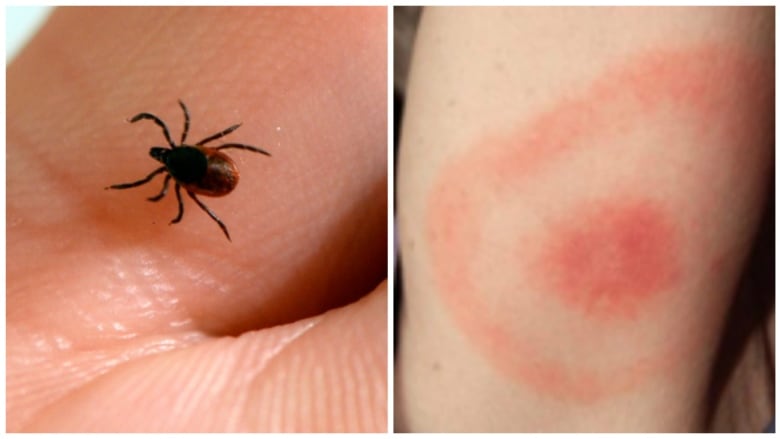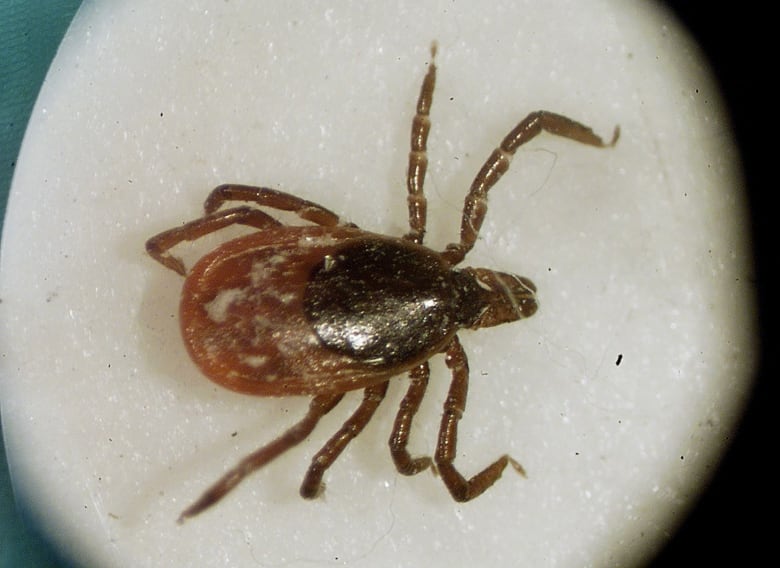How to avoid ticks this summer in Ontario

As the days grow longer and families look forward to summer vacation, Region of Waterloo Public Health is reminding residents to talk ticks.
Ticks like to hang out in shady, moist areas on the tips of long grasses and their golden opportunity to find a meal arrives when the grass is disturbed by wind or legs brushing past.
"They actually just basically walk onto people," Kathryn Bromley, infection control specialistat the Region of Waterloo Public Health told CBC.
Although the risk of running into ticks that carry Lyme disease in Waterloo Region islow, Bromley said camping can increase thatrisk.
Over the years, Lyme disease-carrying black-legged ticks have been found near lakes and provincial parks, which are camper favourites.
- Pet owners warned to beware amid rising cases of deer ticks
- Toronto identifies areas where ticks that cause Lyme disease are found
- Lyme disease researcher says he's surprised by recent northwestern Ontario findings
"Because you're sort of in the environment that the ticks like, there is the opportunity to definitely pick up ticks when you're out camping," said Bromley.
Even if the campgrounds are dry, the high risk comes from hiking through wooded areas with long grasses, she said.
Hungry ticks can be deterred. When outdoors use insect repellent containing DEET or Icaridin #FightTheBite https://t.co/E3gPlvUtaY pic.twitter.com/dj4u3U4Enb
—@ROWPublicHealthBromleygave the following tips for campers:
- Wear lightly-coloured clothing and long sleeves.
- Use DEET-type insect repellent, similar to ones used for mosquitoes.
- Put camping clothes into dryer for an hour when you return.
- Shower to remove ticks that haven't attached.
- Search hidden areas like armpits, behind the knee and in the hair for ticks.

Pluck, not burn
The best way to remove a tick is to grab it with a pair of tweezers as close to the skin as possible, and pull straight up without twisting, said Bromley.
She said it's a misconception that burning ticks off or smothering them with petroleum jelly or nail polish are effective.
She warned that those techniques could stress the tick, causing it to release the saliva that contains the disease-causing bacterium.
The time delay in waiting for the tick to fall off is also not ideal.
"When you see a tick, you want to remove it immediately," said Bromley.
- Why Lunenburg County residents want to 'up the priority' on a Lyme disease vaccine
- Opening the cottage this weekend? Tips for getting back to living at the lake
Children campers
Bromley suggested a number of things parents can do for their children who are off to sleep awayor day camps:
- Packlong sleeves and lightly-coloured clothing.
- Teachchildrenabout staying on groomed trails and keeping to sunny areas on short lawns.
- Packinsect repellent.
Homeowners who live on property backed by wooded areas can also move play areas into a sunny spot where the grass is kept low.
A circular rash referred to as a bulls-eye could be an early symptom of Lyme Disease #FightTheBite https://t.co/E3gPlvUtaY pic.twitter.com/STb6Pa2YVt
—@ROWPublicHealthBull's eye
It can take weeks forLyme disease symptoms toappear. The first sign is typically a rash that looks like a bull's eye.
Bromley suggested these follow-up strategies after a bite:
- Check for rashes in the following weeks.
- Watch out for fevers, chills and extreme fatigue.
- Save ticks and bring them to your regional public health unit to identify them.
The region's public health has a map of Lyme disease risk areas for anyone considering travelling outside the region.Public health also advises people to seek medical attention immediately if they're worried about an infection.












_(720p).jpg)


 OFFICIAL HD MUSIC VIDEO.jpg)
.jpg)



























































































